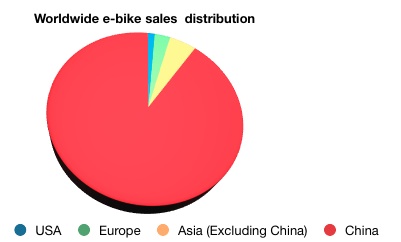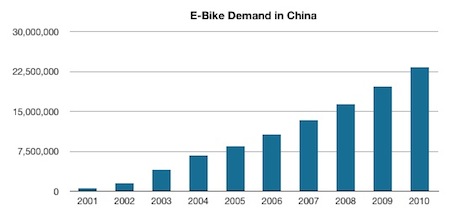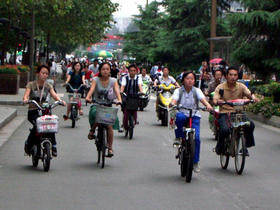Site Map FAQ Link Contact About
The Chinese Electric Bike Market

Millions of electric-assist bicycles, mopeds and electric scooters are sold every year in China, providing affordable transportation in already congested Chinese cities. Photo credit: Patrick Benjamin.
There are two points of view that are related to the chinese electric bike market.
The first one is about China super size e-bike market and the second one is regarding the quality of Chinese electric bike.
China super size e-bike market
Worldwide e-bike sales in 2010 estimated to be 24 million. About 300,000 in USA, about 700,000 in Europe, 1.2 million in India, Japan and Taiwan, and 21.6 million in China!

Electric bike sales have grown far faster than the sales of any other mode of transportation in China, from a modest 150,000 units sold in the late 90s to more then 20 million today. That’s three times as many as the most optimistic projections for cars sales in China for the near future.

Therefore, the implications of this technology on China, both positive and negative, on urban traffic, industry development, energy use, and many other aspects, are huge.
The extraordinary growth of the e-bike market in the late 90s to the present is due to a combination of:
Technology
E-bike technology, specifically motors and batteries, improved significantly during the late 1990’s. Simple technology, a vast supplier base, and weak intellectual property protection made it easier for e-bike makers to enter the industry, increasing competition and driving prices down.
All in all, there is an astonishing number of several hundreds companies manufacturing electric bikes in china nowadays..
Also, the weak protection of intellectual property caused more companies to increase there R&D efforts as this was the only solution in fighting against the law violating companies.
Many big-brands bicycle makers have many factories in China. For example, Giant, a leader in bicycling manufacturing, have a couple of factories.
Economic
Electric bicycles are a mode of transportation that provides high levels of personal mobility at low cost. The improving economic in China allowed many to buy e-bikes.
The typical chinese electric bike users would use a bus or a bicycle if s/he wouldn't own an electric bike. In China, it is a higher quality mobility option in comparison to public transport.
At 1500 to 3000 yuan (about 180 to 360 US dollar), an electric bike is buyable at a small fraction of the cost of a car and it is becoming affordable to more and more chinese people.
Apart from the reduction of e-bike prices over the years, gasoline prices rose and electricity prices in rural areas dropped, making e-bikes more competitive economically with alternatives like gasoline-powered scooters.
Regulations and the urban fabric
Bicycles, estimated at 450 million, have been and still remain the dominant vehicle in Chinese cities, mainly due to low income, high population density (and thus short trips), and extensive bicycle infrastructure (e.g. lanes, parking).
Electric bikes allow people to commute for longer distances and carry more cargo. It becomes an important advantage as China's cities are expanding more and more.
Electric bikes beat subways for convenience, buses (and in many cases also cars) for speed, and both when it comes to health concerns: the overcrowded transit system is feared for its potential to spread disease (e.g. SARS).
Electric bikes have improved the mobility of the elderly, who often have the responsibility of transporting children.
E-bike standards and road rules are set by national government (China Bicycle Association), but it is up to local governments to decide how to enforce these product standards and manage traffic.
Some local government policy motivated by energy and air quality issues created favorable conditions for e-bike growth but other have banned them altogether, alleging environmental drawbacks and concerns about public safety.
Therefore, e-bike penetration is noticeably different from city to city. Some cities have low adoption, like anti e-bike Beijing (<10%), while others have high adoption, like pro e-bike Chengdu (>50%).
The lack of growth in “anti e-bike” cities is an important lesson on the powerful impact of regulatory policy.
In smaller cities and countryside where income rises, e-bikes may eventually replace the bicycles which are still the potentate mode of transportation.
The two sides of the e-bike coin
Some people advocates that e-bikes will continue to grow in popularity as income rise and cities expand. It is clear that income is not the only factor contributing to the popularity of electric bikes; their performance characteristics and built in advantages make them a popular mode for all income classes.
But, we can't neglect that fact that China is following the path of Western countries, rapidly redesigning its cities around the automobile. Houses are springing up in the suburbs, just as they did in the West decades ago. The automobile is king in this model, because in the absence of extensive public transit, cars are the only way to get from distant suburbs to offices and industry parks.

Reference list
- China’s cyclists take charge, June 2005, IEEE Spectrum
- The future of electric two-wheelers and electric vehicles in China, Institute of Transportation Studies, University of California, Davis, CA, USA, Energy Policy
- The Transition to Electric Bikes in China: Effect on Travel Behavior, Mode Shift, and User Safety Perceptions in a Medium-Sized City, Weinert, Ma, Yang, Cherry
- The Transition To Electric Bikes In China: History And Key Reasons For Rapid Growth
Quality of Chinese electric bike
Why are this Asian e-bikes are so damn cheap?
There are probably two reasons for that. And the real answer is found somewhere in between.
- The chinese electric bike industry is huge, about 20 million e-bikes are manufactures there each year. So as with any large industry (not necessarily mature), production costs are getting lower with time.
- Because of aggressive competition and financial pressure, manufactures try to cut expenses at all cost. The result is quite a low quality e-bikes. Many bicycles and electrical system made by Asian manufactures come with dubious quality parts and assembly.
So don't be fooled by the price tag. In the long run, it can cost you more than a quality electric bike.
But, on the other hand, it's not always the case and you can purchase an e-bike which is going to be just fine. You just have to make sure to look hard, know what you want and research.
For example, an average Chinese bike's motor supply a 10 newton meters of torque, while a top of the line electric bike can produce a sweeping 90 newton meters. If you know that, and you know that 10 newton meters is enough for you, you can do a intelligent choice.
Don't be the next innocent person who buy cheap internet e-bikes from China and get an almost entirely not functional junk
If you decide to buy an electric bike, a conversion kit or individual parts from China, you should think about the following issues:
- Have guarantee, some kind of warranty that is going to be accepted. Be sure that you should be able to get spare parts and fix your e-bike if necessary. Durability, quality and water-resistance are very important features. A good warranty offer is an indication that such features exists.
- Also remember that e-bikes have some kind of privilege when it comes to law and taxes. Different countries have different regulations and it is possible that you will buy an Asian legal bike which is illegal in your own country.
- Certification means that the manufacture has passed some kind of tests. There are different kinds of certification tests which includes environmental standards tests, safety tests, quality tests and more. It is a good sign if the e-bike manufacture has qualified in one or more of this tests.
- Have a reliable communication channel. Meaning, have someone to talk to!
Return from Chinese Electric Bike to Electric bicycle news from around the world
|









New! Comments
Have your say about what you just read! Leave me a comment in the box below.